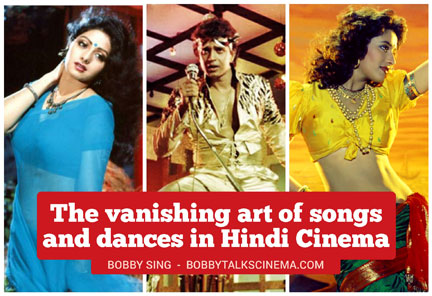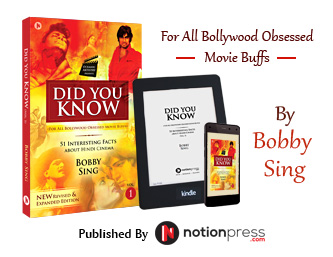
The recent web series Grahan, based in 1984, has a theatre sequence, where Subhash Ghai’s Hero is being played and a young girl is immensely enjoying its hit song ‘Tu mera jaanu hai’. The lead, continuously observing her sitting at a distance, notices the disappointment on her face when the song ends. He gets up and suddenly goes out of the theatre for a while. The moment he returns, the song again gets played on the screen and the audience is overjoyed, including the young girl. In reality, he had gone to the projection room instructing the song to be replayed, using his local influence.
The sequence might appear to be over-the-top or unrealistic to the ‘new age audience’, but that’s exactly how it used to be in the single screen theatres before the multiplex culture took over.
Melodious songs and dance numbers were always an integral part of our storytelling, receiving special attention and time, right since the beginning. In fact, many of our blockbusters have worked just because of their hugely popular songs and dance numbers. Moreover, distributors made a firm demand for them as these added to the repeat value of the film and could create an unbelievable kind of environment in their screenings.
Even when the decades before the ‘70s were much calmer in comparison, instances of theatres transforming into a lively place with shouts, whistles, and people dancing on the songs were often heard, along with instances of coins being thrown towards the screen expressing their appreciation. The aggression grew in the ‘70s with films breaking the set pattern and the hero getting into the mode of an angry young man. The ‘80s and early ‘90s witnessed a different kind of peak in such celebrations when the families stayed away from the theatres (due to Doordarshan and VCR coming in) and the films mostly focusing on action. Still, we witnessed jubilees being celebrated, largely because of their songs and dance numbers as Disco Dancer, Ilzaam, Chandni, Qayamat Se Qayamat Tak, Tezaab, Maine Pyar Kiya, Chaalbaaz, Aashiqui, Hum, Dil, Khalnayak, Roja and many more. The songs getting repeated on public demand were often seen in these films, as authentically shown in the series Grahan.
Towards the mid-90s, the family audiences returned to the theatres, changing the entire perception with Hum Aapke Hain Kaun in particular. Rajshri released the film with a solid strategy to bring them back and the songs once again played a major role in winning over the families. As the business witnessed a revival, the musical insertions remained the key attraction in hits like Raja, Dil To Pagal Hai, Govinda-David Dhawan films, Dilwale Dulhaniya Le Jayenge, Raja Hindustani, Rangeela, Bombay, Kuchh Kuchh Hota Hai, and more.
However, with the multiplex culture knocking at the doors, the scenario gradually started changing in the first decade of the new millennium with lesser films being talked about for their soundtrack and dance sequences. The introduction of digital medium in music, crushing the physical format, further consolidated this decline and suddenly a soundtrack was no more considered a major component of a project.
Creating a new format, the full-length songs and dance sequences started vanishing from our films, substituted by their 2-minutes edited versions. Moreover, lip-synching went out of trend and the tracks were mostly playing in the backdrop. As a result, the songs and dances became unimportant, unless it was a film directed by creators like Sanjay Leela Bhansali or a subject entirely based on song or dance competitions.
Coming to the present, the OTT revolution has been contributing as the last nail in the coffin of songs and dance numbers in our Hindi cinema. With crime-dramas being watched the most and the play-slider in control of the user, no maker or production house wants the viewer to use the fast-forward option while viewing their content. Hence, they don’t think about songs or dances while conceiving their films or web series. And if required, anything can be added as a filler, the best being a short Hindi version of an already hit Punjabi song.
Indicating towards an unseen tragedy, just try to recall which film soundtrack you last bought for your listening pleasure? Which sad song of a film you last cherished playing on a repeat mode, or which new Hindi film you simply watched only because of its songs? The answers would reveal how songs and dance numbers are no more considered an integral part of our films as they once used to be.
Interestingly, the south cinema still likes to rely on them, but in Hindi films, we have probably lost the vision of delivering a hit because of the songs. Is this the end of these musical art-forms in our Hindi cinema? It certainly isn’t, but the revival also appears to be an extremely difficult task to achieve.
Cheers!
Bobby Sing
bobbytalkscinema.com
NOTE : The article was first published in THE FREE PRESS JOURNAL Newspaper (Mumbai Edition) on 11th July 2021.
Note : The write-up is a chapter shared from my upcoming book releasing soon. So any additions, rectifications suggested by friends are welcome to make it better.
----------
 For more such interesting articles on lesser known facts on Hindi Cinema, do try DID YOU KNOW
For more such interesting articles on lesser known facts on Hindi Cinema, do try DID YOU KNOW Series by
Bobby Sing available in both
Book and
E-book form
.
Also available
at Notionpress and Flipkart stores (in India)
The book is now also available in Hindi titled ITNA TO YAAD HAI MUJHE published by Prabhat Prakashan
Available at all leading portals online.


 For more such interesting articles on lesser known facts on Hindi Cinema, do try DID YOU KNOW Series by Bobby Sing available in both Book and E-book form.
For more such interesting articles on lesser known facts on Hindi Cinema, do try DID YOU KNOW Series by Bobby Sing available in both Book and E-book form.